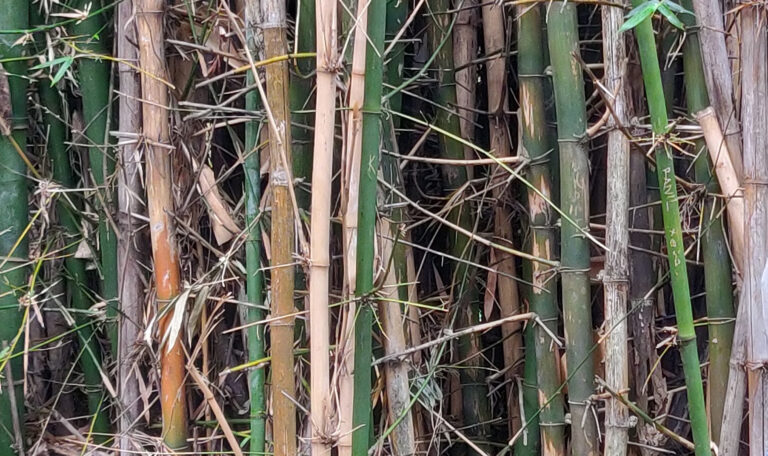Botanical: Bambusa vulgaris | Hindi: बांस | Marathi: बांबू | English: Bamboo
About
Bamboo, a versatile member of the grass family (Poaceae), is characterized by its tall, hollow, and segmented stems. With rapid growth and remarkable strength, some species can reach heights of over 100 feet. Bamboo leaves are typically narrow and elongated, forming dense canopies. The plant’s unique flowering pattern, known as gregarious flowering, occurs at long intervals, often spanning several decades. Notable for its resilience and adaptability, bamboo thrives in diverse climates, contributing to its global distribution.Interesting Facts

Medicinal Uses: Bamboo has a rich history in traditional medicine, particularly in Asian cultures. Its extracts are believed to possess anti-inflammatory and antioxidant properties, aiding in the treatment of various ailments. Bamboo shoots are used to address digestive issues and respiratory conditions, while the silica-rich sap is considered beneficial for skin health. Additionally, bamboo leaves are infused for their potential diuretic and anti-cancer properties. Though more research is needed, these traditional uses underscore the plant’s significance beyond its structural and decorative applications.

Culture and Tradition: Bamboo holds profound cultural significance globally, symbolizing strength, resilience, and flexibility. In Asia, it’s revered as a symbol of longevity and is integral to traditional ceremonies. Bamboo’s versatility extends to handicrafts, where it is fashioned into art, musical instruments, and furniture. In some cultures, bamboo is associated with good luck and protection from evil spirits. Its sustainable qualities align with ecological values, making it an emblem of environmental harmony. The use of bamboo in construction, tools, and daily life showcases its enduring role in preserving cultural heritage and fostering sustainable practices.

Environmental Impact: Bamboo plays a pivotal role in environmental conservation due to its rapid growth and carbon sequestration capabilities. Its extensive root system prevents soil erosion and stabilizes riverbanks. Bamboo forests contribute significantly to oxygen production, fostering a healthier atmosphere. As a renewable resource, bamboo requires minimal water and no pesticides for cultivation, making it an eco-friendly alternative to traditional timber. The plant’s ability to thrive in degraded lands further enhances its ecological impact, promoting biodiversity. Embracing bamboo in various industries, from construction to textiles, offers sustainable solutions, demonstrating its vital role in promoting a greener and more sustainable future.

Food & Culinary usage: Bamboo shoots, young and tender portions of the bamboo plant, are culinary treasures in many Asian cuisines. With a mild, slightly sweet flavor and crisp texture, bamboo shoots are a popular addition to stir-fries, curries, soups, and salads. Rich in fiber, low in calories, and packed with nutrients, they contribute to a healthy diet. Beyond the shoots, bamboo leaves are used to wrap and steam food, imparting a subtle fragrance. Bamboo’s versatility in the kitchen reflects its cultural importance, as communities have embraced its nutritional value and unique taste for generations.
Anandvan Trivia Quiz
Question 1: What’s my relationship with the invention of light bulb?Answer: We all know of Thomas Alva Edison as inventor of the light bulb. During his research while trying to find a solution to make the bulb’s filament last long enough to be viable, he experimented with filaments made of several materials. Most lasted only a few hours. Edison finally achieved a 1,200 hour burning time with filament made using a carbonized bamboo strand. The bamboo filament based bulbs remain a standard for almost 10 years until filaments made of tungsten replaced them.

